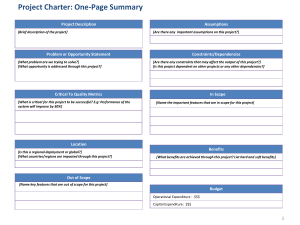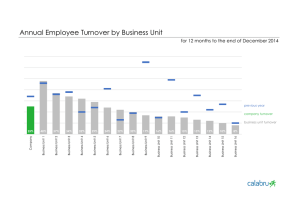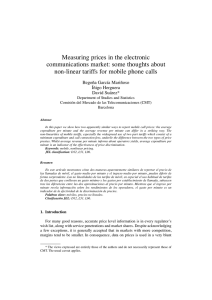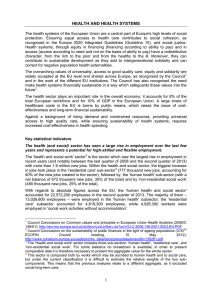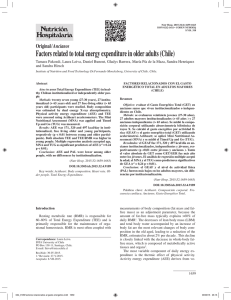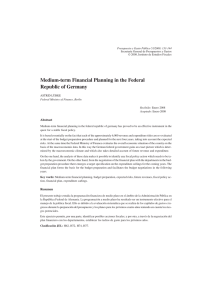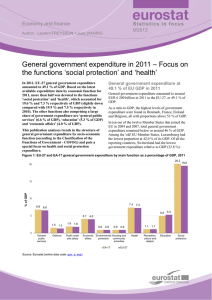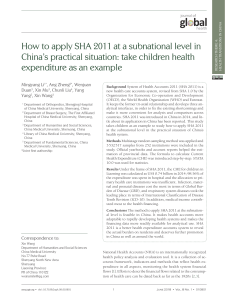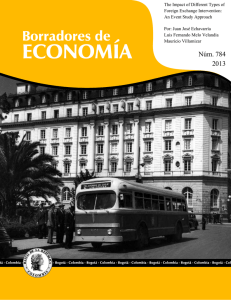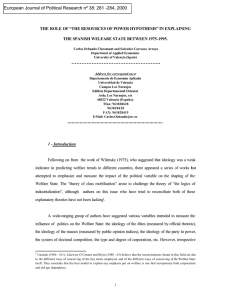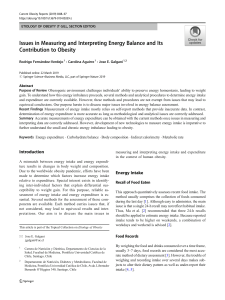General methodology
Anuncio
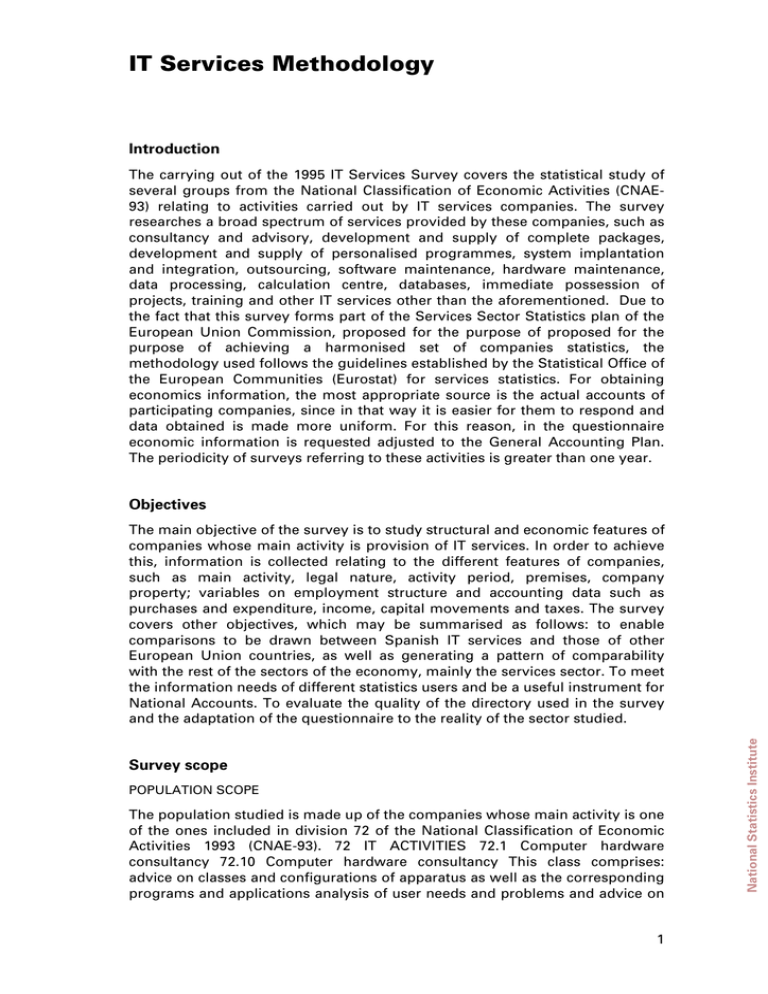
IT Services Methodology Introduction The carrying out of the 1995 IT Services Survey covers the statistical study of several groups from the National Classification of Economic Activities (CNAE93) relating to activities carried out by IT services companies. The survey researches a broad spectrum of services provided by these companies, such as consultancy and advisory, development and supply of complete packages, development and supply of personalised programmes, system implantation and integration, outsourcing, software maintenance, hardware maintenance, data processing, calculation centre, databases, immediate possession of projects, training and other IT services other than the aforementioned. Due to the fact that this survey forms part of the Services Sector Statistics plan of the European Union Commission, proposed for the purpose of proposed for the purpose of achieving a harmonised set of companies statistics, the methodology used follows the guidelines established by the Statistical Office of the European Communities (Eurostat) for services statistics. For obtaining economics information, the most appropriate source is the actual accounts of participating companies, since in that way it is easier for them to respond and data obtained is made more uniform. For this reason, in the questionnaire economic information is requested adjusted to the General Accounting Plan. The periodicity of surveys referring to these activities is greater than one year. Objectives Survey scope POPULATION SCOPE The population studied is made up of the companies whose main activity is one of the ones included in division 72 of the National Classification of Economic Activities 1993 (CNAE-93). 72 IT ACTIVITIES 72.1 Computer hardware consultancy 72.10 Computer hardware consultancy This class comprises: advice on classes and configurations of apparatus as well as the corresponding programs and applications analysis of user needs and problems and advice on 1 National Statistics Institute The main objective of the survey is to study structural and economic features of companies whose main activity is provision of IT services. In order to achieve this, information is collected relating to the different features of companies, such as main activity, legal nature, activity period, premises, company property; variables on employment structure and accounting data such as purchases and expenditure, income, capital movements and taxes. The survey covers other objectives, which may be summarised as follows: to enable comparisons to be drawn between Spanish IT services and those of other European Union countries, as well as generating a pattern of comparability with the rest of the sectors of the economy, mainly the services sector. To meet the information needs of different statistics users and be a useful instrument for National Accounts. To evaluate the quality of the directory used in the survey and the adaptation of the questionnaire to the reality of the sector studied. possible solutions. This class excludes: advice on IT equipment associated with the manufacture or sale of computers. 72.2 Software consultancy and supply 72.20 72.2 Software consulting and software supply This class includes: analysis and resolution of the needs and problems of users. Creation, production, supply and documentation of bespoke programs subject to specific user orders. Creation, production, supply and documentation of programs, including publishing, for clients (non-bespoke). This class excludes: the reproduction of IT programs for their commercialisation. 72.3 Data processing 72.30 Data processing This class comprises: processing data supplied by the client: complete processing of data. Data entry services: recording, optical reading, etc. Ongoing and management and use of data processing facilities. 72.4 Database-related activities 72.40 Database-related activities This class includes: activities related to databases: setting up databases. Database query service: supply of data in a specific order or sequence, by means of recovery or access by direct line (computerised management), so that they are accessible to all or a limited number of users and are in the order requested. Maintenance and repair of office, accounting and computing equipment 72.50 Maintenance and repair of office, accounting and computing equipment This class excludes: installation of computers and IT equipment associated with its manufacture and associated with sales. 72.6 Other computer-related activities 72.60 Other computer-related activities TIME SCOPE The survey's reference period is the 1995 financial year, except for the number of establishments and staff employed variables, which take the 30 September 1995 as the reference date. GEOGRAPHICAL SCOPE All statistical units located in Spanish state territory are object of investigation. The statistical unit can be defined as the element or component of the population under observation and investigation referred to in the tabulation of the data of the statistical aggregates obtained as a result of the surveys. It has been used as the only statistics for the company whose main activity is the provision of IT services described in the population scope. The company is also the informant unit, because, since it is perfectly defined and located, and since it has the accounting and employment data available, the response is provided and homogeneous information is obtained. The company is the smallest combination of legal units that constitutes an organisational unit that produces goods or services, and which has a certain degree of decision-making autonomy, especially in relation to the allocation of their current resources. A company may carry out one or more activities in one or several local units. A company can correspond to one single legal unit. 2 National Statistics Institute Statistical units Company features MAIN ACTIVITY Production activity entitled economic activity is the result of a combination of resources that lead to the creation of specific goods or the provision of specific services that can be quantified monetarily. An activity is characterised by product entries (goods and services), a production process and the products created. A company's main activity is regarded as being that which contributes most to its added value, which in this survey is the provision of IT services. Nevertheless, due to the difficulties faced by companies in calculating added value when various activities are carried out, the activity which generates the greatest turnover is considered the main activity or, failing that, the activity which employs the greatest number of persons. Companies may carry out activities other than that defined as the main activity, as secondary activities. Secondary activities are generally carried out jointly with the main one, although in some cases it may be carried out independently and even in premises other than those given over to the main activity. Secondary activities on which information is obtained are those most closely tied to IT services. It considers: Manufacture of IT equipment. Marketing of IT equipment. 2.3 supply of auxiliary material. IT activities other than those mentioned. Information has not been collected on companies whose main activity is different to the population scope of the survey, even though they also provide IT services as a secondary activity. LEGAL NATURE This is the legal status under which the company operates. The following categories are considered: individual: includes those companies belonging to one or various individuals without the formalisation of the company or group appearing in the legal document. Included here are individual companies made up by free or independent professionals. Legal entity: those companies to which the law grants capacity to exert rights and assume obligations have legal personality. The following modalities are distinguished: Public limited company. Private limited company. Other legal statuses such as: general partnerships, limited partnerships, joint ownership, cooperatives, foundations, etc. The survey collects information on the seniority of companies and the intensity of their activity. The seniority is determined in relation to the number of years that the company has been carrying out its activity and the intensity is determined by understanding the number of months of activity during the reference year. NUMBER OF PREMISES The degree of multi-location of companies depends on the number of premises that these have in Spain. All structurally separate and independent enclosures not given over exclusively to a family dwelling and in which economic activities dependent on a company are or can be carried out are regarded as premises. Information is collected on the number of premises the company uses in order 3 National Statistics Institute ACTIVITY PERIOD to carry out its activity, including those given over to secondary and auxiliary activities. 30th September1995 is used as a reference date. COMPANY PROPERTY The high degree of internationalisation of the IT sector, as well as companies' connection to others, including those from other sectors, makes it necessary to study the features of company property. The company group brings together a number of companies that are legally or financially linked. The group of companies can involve a number of decision-making sources, mainly in terms of policies on production, sales and profits, and can standardise certain aspects of financial and tax system management. It consists of an economic unit, which can make choices that particularly affect the associated units making up the unit. Where the company investigated belongs to a group, the country where the group leader is based is requested, this being the legal parent company, which is not controlled by any other legal unit. Information is also collected on the degree of participation of other companies in the capital stock of the companies studied, differentiating whether they are national, or foreign from different geographical areas, and showing the percentage of participation in each case. Employment Employed staff is considered to be all persons working in the observation unit, producing goods, providing services or carrying out auxiliary activities. Employed staff includes: owners working for the company, active partners, as well as unpaid family assistance. Persons who work outside the company, but who are part of the company and are paid by the company. Persons absent for a short period such as, for example, sick leave, paid holiday or exceptional leave. Staff on strike. Part time employees. Not included as employees: persons with restricted permission, such as retired persons or those in the army, unless they are truly working in the company. Staff who work at the company's premises, but rely on another company for their salary. Staff who work on commission without receiving a fixed salary from the company. Independent professionals and, generally, those linked to the company by a commercial contract. Members of the Board of Directors who do not really work for the company. Different staff classifications are established in accordance with different criteria. a) By remuneration: unpaid staff: made up by persons who direct or actively participate in company work without receiving fixed remuneration or salary. Included are owners, partners who are active within the company, freelance workers and family assistance. Not included are partners who solely contribute capital, nor family members of the proprietor who do not actively participate in the company. Paid staff: this consists of those employees linked to the company by a labour contract and who are paid fixed or periodic amounts in the form of a wage, salary, commission, efficiency wage or payments in kind. Within the paid staff group, we distinguish between permanent paid personnel, who are those persons with a contract or indefinite employment connection with the company and temporary paid personnel, who 4 National Statistics Institute EMPLOYED PERSONNEL are those persons that have fixed term contracts. b) By their functions in the company. Company staff are classified by area of work in which they carry out their functions, these being: -executive, administrative and commercial. Software technicians: consultants, analysts, programmers, systems and research and development technicians. Maintenance technicians. Others: training and other staff dedicated to functions not mentioned above. c) By type of working day: full-time staff. Part-time personnel: this category includes all forms of part-time work, such as half-day work, work limited to a number of days per week, etc. d) By professional category. Staff are classified in accordance with the professional category in their company and not their academic qualifications in: engineers and university graduates. Technical engineers, experts and qualified assistants. Others. e) By age group: under 25 years old. 25 to 40 years old. Over 40 years old. f) By sex. All company workers are differentiated by sex. For all previous staff classifications, the reference date taken is 30th September 1995. STAFF EMPLOYED BY QUARTER DURING 1995 Staff may vary throughout the year due to the needs of the companies, or their opening or closing over the period. Taking the number of employed persons on the last day of each quarter, of each quarter, the average for employed persons is calculated, giving an overview of employment evolution over the course of the year HOURS WORKED BY EMPLOYED STAFF This covers the number of hours actually worked by all employed staff over the course of the year. They do not necessarily coincide with those shown in labour agreements. This variable includes normal hours plus overtime hours, short breaks, night shifts and working on holidays, etc. It does not comprise holiday periods, public holidays, sick leave, mealtimes and time given over to commuting to work. STAFF TRAINING It includes the number of hours that all employed staff have given over to professional training, within or outside the company, over the course of the year. Purchases of goods and services represent the value of all goods that are different from the investment assets and all services bought during the reference year for re-sale in the state in which they were acquired or following transformation and integration into sold products, or for the current operating of the company. The purchases of goods and services are valued at acquisition price excluding charged and deductible VAT. PURCHASES They are divided into: Purchases of goods. Value of the goods acquired by the company to resell them in the same state in which they were acquired without 5 National Statistics Institute Purchases and expenditure subjecting them to transformation. Purchases of raw materials. Value of goods acquired for their transformation during the productive process. Net purchases of other supplies. Value of purchases of supplies such as fuel, spare parts, packaging, office material, etc. These products are characterised by being storable. Work carried out by other companies. Value of work that, forming part of the production process itself, is ordered and carried out by other companies or professionals. Returns of and taxes on purchases. This comprises the value of returns of and taxes for purchases made by the company. Returns of purchases to suppliers normally for non-fulfilment of the conditions of the order. These are discounts and similar which come about due to having reached a specific turnover. Purchases of merchandise and work carried out by other companies form purchasing of goods and services for resale. Companies have been asked for information relating to net purchases from the different headings shown, in other words, the result of subtracting the values of corresponding returns and taxes from the value of each purchase. This is expenditure by the company incurred for services of a varied nature received from third parties. The following are considered: expenditure on research and development by these services entrusted to other companies. Leases. Value of payments accrued from renting chattel and estate used by the company. Taxes. Fixed or variable amounts that are met through the entitlement to use the different expressions of industrial property. Repairs and maintenance. Maintenance expenditure by third parties on goods including tangible assets. Transport. Expenditure by the company for transport by third parties, where it is not appropriate to include them in the purchasers' price of the purchasing of goods. Insurance premiums. Amounts paid for non-corporate insurance premiums. Including insurance for burglary and robbery, fire, multirisk, vehicles, etc. Advertising, propaganda and public relations. Expenditure on these. Supplies. Value of expenditure by the company on acquiring nonstorable supplies: electricity, water, gas, etc. Other services. This comprises the value of expenditure corresponding to other external services not included in the previous points. Including: independent professional services. Amount that is paid to professionals for services provided to the company. This does not include fees and payments to independent professionals carrying out work forming part of the actual production process of a company. Bank services. Amounts paid for banking services and similar, which are not considered financial expenditure. Other services. These comprise travel expenses, staff allowances, staff transport by means other than those of the company and office expenditure not included in other accounts. PURCHASING AND EXPENDITURE ON EXTERNAL SERVICES ACCORDING TO GEOGRAPHICAL AREAS WHERE THEY ARE MADE Percentages, corresponding to different geographical areas, of the total value of purchases and expenditure on external services by the company for carrying out their activity. Those made outside Spain are imports of goods and services. It considers: Spain, other European Union countries, non-community countries and others. 6 National Statistics Institute EXTERNAL SERVICES EXPENDITURE STAFF COSTS These comprise all remuneration made to all employees in payment of their work, as well as compulsory and optional corporate costs borne by the company. Personnel costs are made up of: gross wages and salaries. Payments, in cash or in kind, with which the company remunerates the work of its employees, without discounting taxes, employee social security contributions and other worker obligations retained at source by the employer company. This does not include payments made to professionals or independent collaborators associated with the company via a commercial company, travel expenses for company staff, Social Security contributions and company pensions schemes, or payments which the company continues to make in case of illness, accident or maternity, considered under the following headings. Indemnities. Amounts paid to company staff to compensate for damages, specifically compensations for dismissal, illness, early retirement, etc. Social Security contributions paid for by the company. This covers obligatory contributions the company makes directly to Social Security, on behalf of its employees, for various services rendered. Other corporate charges. This section includes: contributions to complementary pension systems. Covers the sum of contributions paid into pension plans or similar systems that cover retirement, disability or death, referred to the company personnel, paid by the company by way of collective or contractual agreements or voluntarily. Other social costs. Corporate expenses incurred, by the company in compliance with a legal or voluntary disposition, for its employees. Including subsidies to company stores and canteens, maintenance of schools and vocational training schools, study grants, bonus paid for life insurance contracts, accidents, illness, etc. ALLOCATIONS FOR DEPRECIATION OF FIXED ASSETS These comprise financial year instalments for amortising the annual systematic depreciation of tangible and intangible assets by applying them to the production process. Financial expenditure. They cover costs caused via external financing of the company. Including: interest accrued during the financial year from fixedincome values, regardless of the expiry period and the way in which the aforementioned interests are applied. Value of interest on loans received and other debts pending amortisation. Interests on discounts and other effects. Discounts on prompt payment sales granted by the company to its customers. Losses incurred on the disposal of fixed or variable rate securities. Losses resulting from definite losses from loans. Negative exchange rate differences; losses resulting from modifications in the exchange rate for fixed-yield securities, loans, debts and cash in foreign currencies. Other types of financial expenditure not previously included. Extraordinary expenditure. Losses and expenditure of significant amounts, taking into account company activity, fall outside its ordinary activities and are not expected to occur frequently: expenditure resulting from floods, fires and other accidents, fiscal or criminal penalties or fines etc. 7 National Statistics Institute OTHER EXPENDITURE Stocks Stocks include the value of all goods that are the property of the company except capital goods. These include stocks of goods, raw materials and other supplies. They are valued at their purchasers' price, or at their production cost if they are manufactured by the same company. Stocks are entered into the accounts minus VAT. Stocks are requested at the beginning and end of the reference year. Income This block includes operating and non-operating income for the company during 1995. TURNOVER It is composed of several sections: Breakdown of turnover by service rendered or activities carried out. This section includes percentages which, on the net value of turnover, correspond to the different services rendered or activities carried out by the company. When distributing the net value of turnover, the following is taken into account: 1. IT services 1.1 Consultancy and advisory. This includes: services for analysing the organisation's IT needs. Planning of acquisitions by the organisation, client consultancy regarding the acquisition of equipment and software. Carrying out of IT audits for the organisation. Advisory and consultancy services in IT security. It does not cover: advice on IT equipment associated with the manufacture or sale of computers.(included in points 2.1 and 2.2). 1.2 Development and supply of complete packages (non-bespoke software). This includes: development and marketing services (sales, rentals or concession of licences) for systems and packages for users. Development and marketing services (sales, rentals or concession of licences) for software. It does not cover: retail trade of software packages (corresponding to point 2.4). Design of bespoke programs or modification of software packages in accordance with the needs of specific users (included in 1.3). 1.3 Development and supply of customised programs (bespoke software). This includes: development and market (analysis, design and programming) of programs in accordance with the needs of a specific client. Services for modifying software packages. Services rendered by systems analysts and/or programmer charging daily rates for their involvement in the phases of development of system. The client oversees and reserves the rights of the results of his or her work. 1.4 Establishment and 8 National Statistics Institute Net turnover. This comprises the amounts invoiced by the company for rendering services and selling goods and products that are the object of the company's business. Includes all taxes that are placed on invoiced goods or services with the exception of VAT having an effect on clients. It also includes any other expenditure attributable to the customer, such as transport, packaging etc. sales refunds are deducted, as are taxes on sales. Not deducted are cash discounts, nor discounts for prompt payment. Turnover does not include the sale of fixed assets or operating subsidies. 9 National Statistics Institute integration of systems. This includes: carrying out feasibility studies for the implementation of a system. Preparation of specifications for designing a database. Specialised technical Advisory for the integration of equipment and programs. Preparation of specifications for designing database security, etc. It does not cover: consultancy related to retail trade (included in point 2.4). Design of customised programs (belonging to 1.3). training (included in 1.12). outsourcing (1.5. This includes: external management of information systems, in full or in part, temporarily or permanently. Different types of services: logic outsourcing (external management of software development and maintenance), communications, calculation centre and global outsourcing. 1.6 Maintenance of software. This includes: maintenance IT systems systems (programs) in good working order. Corrective and preventive maintenance services. Services such as checks for detecting, locating and removing errors, improvements to programs in use, updating of user handbooks and advisory regarding correct use of a system. 1.7 Maintenance of hardware. This comprises: maintenance services for machinery and equipment. Services for installing software packages or extensions to equipment or programs. It does not cover: systems and programs maintenance services, including services for perfecting these(included in 1.6). installation of computers and IT equipment associated with its manufacture (2.1) or sale (2.2). 72.3 Data processing. Calculation centre. This includes: data processing services for data supplied by the client, tabulation, calculation, etc., without designing specific programs. Services for renting machine time (central processing unit time) of the data processing system to third parties, time shared with other users. Data entry services (provided by the client) on tapes, disks or other media or directly into a data processing system. Disk and tape conversion and rectification services. Preparation services for data entry. Optical character recognition services. It does not cover: outsourcing (1.5). IT media reproduction services (belonging to 2.4). 1.9 Databases. This includes: database development services: data collection from one or more sources. Data entry services: preparation of a model of an IT form for registering anticipated information in predefined format. Database query services: supply of data in a specific order or sequence, by means of recovery or access by direct line (computerised management), so that they are accessible to all or a limited number of users and are in the order requested. It does not cover: rendering of telecommunications network services (leased networks, public data networks or lines) necessary for accessing databases. Document investigation series (this is not an IT service, included in 3.1). 1.10 Added-value services. These services are closely liked to telecommunications, therefore companies whose main activity is the rendering of these services have been included in the 1995 Postal services and communications survey. They may appear in this survey as a secondary activity of companies whose main activity is IT services. These comprise: Added-value services telecommunication networks, such as basic network and network outsourcing services, information services, courier services and transactional services. Immediate possession of projects. This includes: the supply of turnkey solutions, including hardware, software and necessary services. 1.12 Training. This includes: training in the use of information equipment and systems. Training in the use of commercial or customised software. It does not cover: academies offering general IT courses. 1.13 Other IT services. This includes: services not already included elsewhere. 2. Other computing activities. Manufacture of IT equipment. This includes: manufacture of machines for automated data processing. Marketing of IT equipment. This includes: wholesale trade of computers and peripherals. 2.3 Supply of auxiliary material. This includes: companies supplying paper, disks, toner, magnetic media, etc. 2.4 Other activities not previously shown. This includes: all other IT activities no previously described, such as for example retail trade in computers and software not manufactured in accordance with specifications. 3. Other activities and services. This includes: activities and services other than those from the IT sector and which the company invoices for. Breakdown of turnover by geographical area where sales are made. Percentages over the net value of turnover corresponding to the different geographical areas. Invoicing outside Spain corresponding to exports. It considers: Spain, other European Union countries, non-community countries and others. Breakdown of turnover by the client's sector of activity. This includes the percentage distribution of the net amount of turnover by activity sector in which clients are active. Distinction is made between: Public Administrations: Central, Autonomous or Local. Public service companies: transport, telecommunications, electricity, water, gas, education and health services. Finances: financial and insurance organisations. Distribution: commercial activities. Industry: including construction. Other services. OTHER OPERATING INCOME This section includes operating income concepts: originating from the following Tasks performed by the company on fixed assets. These are those carried out by the company for its non-fixed assets by means of equipment and personnel. This may affect fixed assets, both tangible and intangible. Other management income. This section includes operating income not already covered, such as: income from lettings: that obtained from letting chattels or estate granted to third parties. Royalties received from concessions, patents, licences, trademarks and other similar rights: fixed or variable amounts which are met through the entitlement to use the different expressions of industrial property Income from commissions: fixed or variable amounts as a counter provision to mediation services carried out accidentally. Income from services to the staff: due to services such as company stores, transport, dwellings, etc., provided to staff by the company. Miscellaneous operating income: caused by the temporary provision of certain services to other companies or individuals (transport, repairs, advice, reports, etc.) 10 National Statistics Institute Operating subsidies. These are transfer amounts granted to the company by Public Administrations with the objective of ensuring minimal profitability, compensating operation deficit or facilitating sufficient remuneration of production factors. not included are those carried out by own partners or companies in the group, multigroup or associates. Nor are included those quantities received under the form of tax exemption of help for investment OTHER INCOME Financial income. They cover the total value of financial income obtained by the company during the reference year. Including: income for the company from shares in the capital of other companies, accrued during the financial year. negotiable fixed interest shares, loans and credits on behalf of the company, accrued during the financial year. Loan interest and credit during the financial year. Discounts and similar awarded to the company by suppliers, regardless of whether or not they are included in the invoice. Profit from the transfer of fixed- or variable-yield securities. Profit resulting from modifications in the exchange rate for fixed-yield securities, loans, debts and cash in foreign currencies. Other types of financial expenditure not previously included. Extraordinary income Value of income of a significant amount which may not be regarded as periodic when assessing the company's future operating results. Those that fall outside ordinary activities typical of the company, and which are not expected to occur frequently, are considered extraordinary income. This includes income from the reinstatement of credits that were amortised in the past for definite losses. Stock of finished products in progress Value of the stock of products that are finished or in the manufacturing process that have been produced by the unit and which have still not been sold on the last and first day of year 1995. This includes products belonging to the unit, even though they are in the possession of third parties, and products stored by the unit that belong to third parties are excluded. Stocks are valued at production cost or at acquisition price if they bought from another company without entering VAT into the accounts These include values of acquisition and sales operations, carried out during the financial year, on financial appropriations destined to be used in the company activity on a long-term basis. It also includes improvements, transformations and repairs that prolong normal useful life or increase the productivity of existing fixed capital. It excludes running repair and maintenance costs. They are valued at acquisition price, if bought from third parties and at production cost, if they are produced by the company itself, including installation costs and all possible rights and taxes but excluding charged and deductible VAT and financing costs. Goods sold are valued at the price actually obtained, excluding VAT having an effect on sales. TANGIBLE ASSETS When acquiring and selling tangible assets, the following are taken into account: land and natural goods Constructions and technical installations Machinery, tools, other installations and furniture Information processing equipment Transport elements Other material fixed assets 11 National Statistics Institute Capital transactions INTANGIBLE ASSETS Distinction is made between: Research and development Industrial property Trade fund Computer applications Rights on goods acquired under a leasing system Other intangible fixed assets Taxes Value Added Tax (VAT). The following cases are considered: the company operates under the simplified scheme; in this case, the value of VAT paid to the Inland Revenue is included. The company operates under the general scheme; Charged VAT and deductible paid VAT are requested. Charged VAT is what companies charge their clients and deductible paid VAT is what the companies pay their suppliers for the purchase of goods and services that can be deducted. Transactions carried out within the Autonomous Community of Canarias are not affected by VAT, rather by the General Indirect Tax in the Canary Islands (GITC). Taxes linked to production. These include: economic activities tax (IAE), charged for business and professional activities during the financial year. Taxes linked to imports, such as such as customs duties or taxes and any other type of tax or duty levied on imported products. Other taxes linked to production not already covered, such as for example taxes on operating vehicles, stamp duties and registration, tax on real estate goods, taxes paid to Public Administrations for specific social benefits, etc. Economic groups Gross Added Value at market prices. This is calculated as the difference between production value and operating costs other than those destined for resale: purchases of raw materials, other supplies and external services expenditure. Gross added value at factors cost. This is calculated using the gross added value at market prices, deducting taxes linked to production and adding operating subsidies. Gross operating surplus. This is the difference between the gross added value at factor cost and staff costs. Financial surplus. It is calculated by deducting the financial costs from financial income. 12 National Statistics Institute Production. Production value measures the cost of goods and services produced by the company during the financial year. The production value is defined as turnover, plus or minus the variations of the stocks of finished and semi-finished products and on the goods and services purchased for resale, minus the purchases of goods and services for resale, plus the capitalised production, plus immobilised production and management costs. National Statistics Institute Gross formation of fixed capital Its value is obtained by subtracting transfers of tangible and intangible fixed assets, carried out during the financial year. 13
